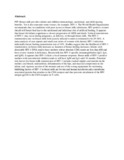| dc.description.abstract | PIP:
Breast milk provides infants and children immunologic, nutritional, and child spacing benefits. Yet it also transmits some viruses, for example, HIV-1. The World Health Organization recommends that, in conditions with poor access to breast milk substitutes, HIV-positive women should still breast feed due to the nutritional and infectious risk of artificial feeding. It appears that breast fed infants experience a slower progression of AIDS and death. Vertical transmission of HIV-1 may occur during pregnancy, at delivery, or through breast milk. The HIV-1 transmission rate via breast milk from acutely infected women is estimated to be 29-36%. A meta-analysis of case reports and small case series of women with chronic HIV-1 infection indicated a breast feeding transmission rate of 14%. Studies suggest that the likelihood of HIV-1 transmission via breast milk increases as duration of breast feeding increases. Infants with detectable HIV-1 DNA tend to have mothers whose absolute CD4 counts are less than 400 and have severe vitamin A deficiency. Breast milk has HIV-1 specific immunoglobulins (IgG, IgA, and IgM). It appears that HIV-1 elicits a local immune response. Breast milk of HIV-1 positive mothers with non-infected children tends to still have IgM and IgA until 18 months. Potential risk factors for breast milk transmission of HIV-1 include cracked nipples and mastitis in the mother; oral thrush, malnutrition, inflammation of the lips, and mucosal compromise in the infant; and vigorous suction of the neonate and use of the wrong equipment for suctioning. Inhibiting factors of HIV-1 in breast milk are bovine and human lactoferrin and a membrane associated protein that attaches to the CD4 receptor and thus prevents attachment of the HIV antigen gp120 to the CD4 receptor on T-cells. | en |

